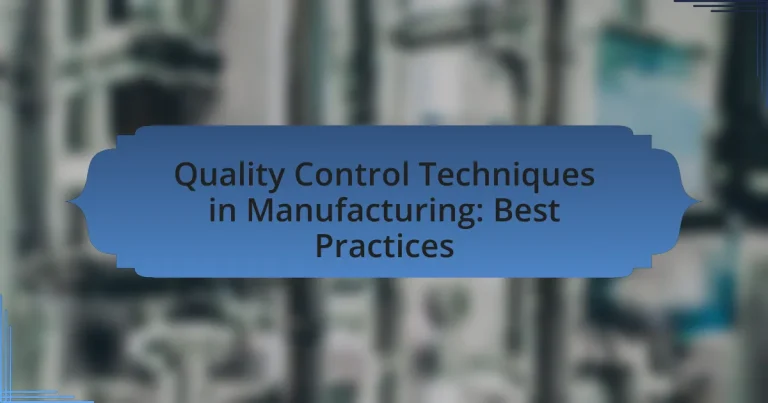Quality Control Techniques in Manufacturing are systematic methods aimed at ensuring products meet specified quality standards. This article explores various techniques such as Statistical Process Control (SPC), Total Quality Management (TQM), and Six Sigma, highlighting their impact on manufacturing processes, objectives, and the importance of maintaining product consistency. It also addresses the risks associated with poor quality control, the role of data analysis, and best practices for implementation, including employee training and the use of automation. By understanding these techniques, organizations can enhance product quality, reduce costs, and improve customer satisfaction.
What are Quality Control Techniques in Manufacturing?

Quality control techniques in manufacturing are systematic methods used to ensure that products meet specified quality standards. These techniques include statistical process control (SPC), which utilizes statistical methods to monitor and control production processes; inspection, which involves examining products for defects; and quality assurance (QA), which focuses on preventing defects through planned and systematic activities. Additionally, techniques such as Six Sigma, which aims to reduce variability and improve process quality, and Total Quality Management (TQM), which emphasizes continuous improvement and customer satisfaction, are widely implemented. These methods are validated by their widespread adoption in industries, leading to enhanced product quality and reduced costs.
How do Quality Control Techniques impact manufacturing processes?
Quality control techniques significantly enhance manufacturing processes by ensuring product consistency and minimizing defects. These techniques, such as Statistical Process Control (SPC) and Total Quality Management (TQM), systematically monitor and improve production quality. For instance, SPC utilizes statistical methods to analyze production data, leading to early detection of variations that could result in defects, thereby reducing waste and rework costs. According to a study by the American Society for Quality, organizations implementing quality control techniques can achieve up to a 30% reduction in production costs while improving customer satisfaction. This demonstrates that effective quality control not only streamlines operations but also contributes to overall business success.
What are the key objectives of implementing Quality Control Techniques?
The key objectives of implementing Quality Control Techniques are to ensure product quality, enhance customer satisfaction, and reduce production costs. By systematically monitoring and controlling manufacturing processes, organizations can identify defects early, leading to improved product reliability and consistency. Research indicates that companies employing effective quality control measures can reduce waste by up to 30%, thereby lowering overall production costs and increasing profitability. Additionally, maintaining high-quality standards fosters customer loyalty, as consumers are more likely to return to brands that consistently deliver reliable products.
How do Quality Control Techniques ensure product consistency?
Quality control techniques ensure product consistency by systematically monitoring and controlling manufacturing processes. These techniques, such as statistical process control (SPC), inspection, and quality audits, help identify variations and defects in products. For instance, SPC uses statistical methods to analyze process data, allowing manufacturers to detect deviations from desired specifications early, thus maintaining uniformity in product quality. Research indicates that companies implementing robust quality control measures can reduce defects by up to 50%, demonstrating the effectiveness of these techniques in achieving consistent product outcomes.
Why is Quality Control essential in manufacturing?
Quality Control is essential in manufacturing because it ensures that products meet specified standards and customer expectations. By implementing systematic processes to monitor and evaluate production, manufacturers can identify defects early, reduce waste, and enhance overall efficiency. According to a study by the American Society for Quality, organizations that prioritize quality control can achieve up to a 20% reduction in production costs and a significant increase in customer satisfaction. This demonstrates that effective quality control not only safeguards product integrity but also contributes to a company’s profitability and reputation in the market.
What risks are associated with poor Quality Control?
Poor quality control poses significant risks, including product defects, financial losses, and damage to brand reputation. Defective products can lead to increased returns and warranty claims, which directly impact profitability. For instance, a study by the American Society for Quality indicates that poor quality can cost businesses up to 20% of their revenue. Additionally, compromised quality can result in safety hazards, leading to legal liabilities and regulatory penalties. Furthermore, a tarnished brand reputation can diminish customer trust, resulting in decreased sales and market share.
How does Quality Control contribute to customer satisfaction?
Quality Control directly enhances customer satisfaction by ensuring that products meet established standards and specifications. When manufacturers implement effective Quality Control processes, they minimize defects and inconsistencies, leading to higher product reliability. According to a study by the American Society for Quality, organizations that prioritize Quality Control can achieve a 20% increase in customer satisfaction ratings due to fewer product returns and complaints. This correlation demonstrates that robust Quality Control practices not only improve product quality but also foster customer trust and loyalty.
What are the different types of Quality Control Techniques?

The different types of Quality Control Techniques include Statistical Process Control (SPC), Acceptance Sampling, Control Charts, and Six Sigma. Statistical Process Control utilizes statistical methods to monitor and control manufacturing processes, ensuring that they operate at their full potential. Acceptance Sampling involves inspecting a random sample of products to determine if the entire batch meets quality standards. Control Charts are graphical tools used to track process variations over time, helping identify trends and anomalies. Six Sigma is a data-driven approach aimed at reducing defects and improving overall quality by using a set of quality management methods. These techniques are widely recognized for their effectiveness in enhancing product quality and operational efficiency in manufacturing.
How do Statistical Process Control (SPC) methods work?
Statistical Process Control (SPC) methods work by using statistical techniques to monitor and control manufacturing processes. These methods involve collecting data from processes, analyzing that data to identify variations, and using control charts to determine whether the process is operating within acceptable limits. By identifying trends and patterns in the data, SPC helps in detecting potential issues before they result in defects, thereby ensuring consistent quality in production. The effectiveness of SPC is supported by its ability to reduce variability and improve process efficiency, as evidenced by numerous studies showing significant reductions in defect rates and cost savings in manufacturing environments.
What tools are used in Statistical Process Control?
Statistical Process Control (SPC) utilizes various tools to monitor and control processes. Key tools include control charts, which visually represent process data over time to identify variations; process capability analysis, which assesses how well a process meets specifications; and histograms, which display the distribution of data points. Additionally, Pareto charts help prioritize issues by showing the most significant factors affecting quality, while scatter diagrams illustrate relationships between variables. These tools collectively enable manufacturers to maintain quality and improve processes effectively.
How can SPC help in identifying process variations?
Statistical Process Control (SPC) helps in identifying process variations by utilizing statistical methods to monitor and control manufacturing processes. SPC employs control charts to visualize data over time, allowing for the detection of trends, shifts, or any unusual patterns that indicate variations. For instance, when a control chart shows points outside the control limits, it signals that the process may be out of control, prompting further investigation. Research has shown that implementing SPC can reduce process variation by up to 50%, leading to improved product quality and consistency.
What role does Total Quality Management (TQM) play in manufacturing?
Total Quality Management (TQM) plays a crucial role in manufacturing by fostering a culture of continuous improvement and customer satisfaction. TQM emphasizes the involvement of all employees in the manufacturing process, ensuring that quality is maintained at every stage, from design to production. This approach leads to reduced waste, improved efficiency, and enhanced product quality, ultimately resulting in higher customer loyalty and market competitiveness. Research indicates that companies implementing TQM practices can achieve significant performance improvements, with studies showing up to a 30% increase in productivity and a 50% reduction in defects.
What are the core principles of Total Quality Management?
The core principles of Total Quality Management (TQM) include customer focus, continuous improvement, employee involvement, process approach, integrated system, strategic and systematic approach, fact-based decision making, and communications. Customer focus emphasizes meeting customer needs and enhancing satisfaction, which is essential for business success. Continuous improvement involves ongoing efforts to improve products, services, or processes, often through methodologies like Plan-Do-Check-Act (PDCA). Employee involvement encourages participation and empowerment of all employees, fostering a culture of quality. The process approach focuses on understanding and managing interrelated processes to achieve desired outcomes efficiently. An integrated system ensures that all organizational functions work together towards quality objectives. A strategic and systematic approach aligns quality initiatives with the organization’s goals. Fact-based decision making relies on data analysis to guide decisions, ensuring they are informed and effective. Finally, effective communication is vital for sharing information and fostering collaboration across the organization. These principles collectively contribute to a culture of quality that enhances organizational performance and customer satisfaction.
How can TQM improve overall operational efficiency?
Total Quality Management (TQM) improves overall operational efficiency by fostering a culture of continuous improvement and employee involvement. This approach emphasizes systematic processes, which reduce waste and enhance productivity. For instance, organizations implementing TQM often experience a 10-30% increase in productivity due to streamlined operations and reduced defects. Additionally, TQM encourages data-driven decision-making, leading to better resource allocation and cost savings. Research indicates that companies practicing TQM can achieve higher customer satisfaction rates, which further drives operational efficiency through repeat business and reduced costs associated with customer acquisition.
What are the best practices for implementing Quality Control Techniques?

The best practices for implementing Quality Control Techniques include establishing clear quality standards, utilizing statistical process control, conducting regular training for staff, and performing frequent audits. Clear quality standards provide a benchmark for performance, ensuring that all team members understand the expectations. Statistical process control helps in monitoring and controlling processes through data analysis, which can lead to early detection of issues. Regular training equips employees with the necessary skills and knowledge to maintain quality standards effectively. Frequent audits ensure compliance with quality standards and identify areas for improvement, thereby enhancing overall product quality. These practices are supported by industry research, which indicates that organizations employing structured quality control techniques experience a significant reduction in defects and improved customer satisfaction.
How can organizations effectively train employees on Quality Control?
Organizations can effectively train employees on Quality Control by implementing structured training programs that include hands-on workshops, online courses, and real-time quality assessments. These programs should focus on the principles of quality management, statistical process control, and problem-solving techniques. For instance, a study by the American Society for Quality found that organizations that invest in comprehensive training programs see a 20% increase in product quality and a 15% reduction in defects. Additionally, incorporating continuous feedback mechanisms and performance evaluations can enhance the learning process and ensure that employees apply quality control techniques effectively in their daily tasks.
What training methods are most effective for Quality Control education?
The most effective training methods for Quality Control education include hands-on training, simulation-based learning, and online courses. Hands-on training allows participants to engage directly with quality control processes, enhancing their practical skills and understanding. Simulation-based learning provides a risk-free environment to practice decision-making and problem-solving in quality scenarios, which has been shown to improve retention and application of knowledge. Online courses offer flexibility and accessibility, enabling learners to study at their own pace while covering essential quality control concepts and techniques. Research indicates that blended learning approaches, which combine these methods, can lead to better outcomes in skill acquisition and knowledge retention in quality control education.
How can continuous improvement be fostered among employees?
Continuous improvement can be fostered among employees by implementing a culture of feedback and training. Organizations that prioritize regular feedback mechanisms, such as performance reviews and peer evaluations, create an environment where employees feel valued and motivated to enhance their skills. Additionally, providing ongoing training opportunities equips employees with the latest industry knowledge and techniques, which is essential for fostering a mindset geared towards continuous improvement. Research indicates that companies with strong training programs see a 24% higher profit margin compared to those without, highlighting the effectiveness of investing in employee development.
What tools and technologies enhance Quality Control practices?
Tools and technologies that enhance Quality Control practices include Statistical Process Control (SPC) software, Automated Inspection Systems, and Quality Management Systems (QMS). SPC software allows manufacturers to monitor and control processes through statistical methods, ensuring that variations are detected and addressed promptly. Automated Inspection Systems utilize advanced imaging and sensor technologies to perform real-time inspections, significantly reducing human error and increasing efficiency. QMS provides a structured framework for managing quality processes, facilitating compliance with industry standards and continuous improvement. These tools collectively contribute to higher product quality, reduced waste, and improved operational efficiency in manufacturing environments.
How do automation and software solutions improve Quality Control?
Automation and software solutions enhance Quality Control by increasing accuracy, consistency, and efficiency in manufacturing processes. Automated systems reduce human error by standardizing measurements and inspections, ensuring that products meet specified quality standards. For instance, the implementation of automated inspection systems can detect defects at a rate of 99.9%, significantly higher than manual inspections, which often miss subtle flaws. Additionally, software solutions facilitate real-time data analysis, allowing manufacturers to identify trends and issues promptly, leading to quicker corrective actions. This proactive approach not only minimizes waste but also improves overall product quality, as evidenced by studies showing that companies utilizing automation report up to a 30% reduction in defects.
What role does data analysis play in Quality Control decision-making?
Data analysis is crucial in Quality Control decision-making as it enables organizations to identify trends, detect anomalies, and make informed decisions based on empirical evidence. By analyzing data collected from production processes, quality control teams can pinpoint areas of improvement, assess product quality, and reduce defects. For instance, statistical process control (SPC) techniques utilize data analysis to monitor process variations, leading to timely interventions that enhance product consistency and compliance with quality standards. This data-driven approach not only improves operational efficiency but also supports continuous improvement initiatives, ultimately resulting in higher customer satisfaction and reduced costs associated with poor quality.
What are common challenges in Quality Control implementation?
Common challenges in Quality Control implementation include inadequate training, lack of management support, and insufficient data analysis. Inadequate training can lead to employees not fully understanding quality standards, which directly impacts product quality. Lack of management support often results in insufficient resources allocated to quality initiatives, hindering effective implementation. Insufficient data analysis can prevent organizations from identifying trends and root causes of quality issues, making it difficult to implement corrective actions. These challenges are frequently cited in industry reports, such as the “Quality Management Practices in Manufacturing” study by the American Society for Quality, which highlights the importance of addressing these barriers for successful Quality Control implementation.
How can organizations overcome resistance to Quality Control changes?
Organizations can overcome resistance to Quality Control changes by implementing effective communication strategies and involving employees in the change process. Engaging staff through training sessions and feedback mechanisms fosters a sense of ownership and reduces apprehension towards new quality control measures. Research indicates that organizations that prioritize transparent communication and employee involvement experience a 70% higher success rate in implementing changes (Kotter, J.P., “Leading Change,” Harvard Business Review Press, 1996). By addressing concerns and demonstrating the benefits of quality control changes, organizations can facilitate smoother transitions and enhance overall compliance.
What strategies can be employed to address Quality Control failures?
To address Quality Control failures, implementing a systematic approach that includes root cause analysis, process standardization, and continuous training is essential. Root cause analysis identifies the underlying issues causing failures, allowing organizations to implement targeted solutions. Process standardization ensures that all operations adhere to established protocols, reducing variability and enhancing consistency. Continuous training equips employees with the necessary skills and knowledge to maintain quality standards, fostering a culture of quality awareness. These strategies collectively contribute to minimizing Quality Control failures and improving overall manufacturing performance.
What practical tips can improve Quality Control in manufacturing?
Implementing standardized procedures is a practical tip that can significantly improve Quality Control in manufacturing. Standardization ensures consistency in processes, which reduces variability and enhances product quality. For instance, adopting ISO 9001 standards can lead to improved operational efficiency and customer satisfaction, as evidenced by a study showing that organizations implementing these standards saw a 20% increase in quality performance metrics. Additionally, regular training for employees on quality standards and procedures fosters a culture of quality awareness, further contributing to enhanced Quality Control.




